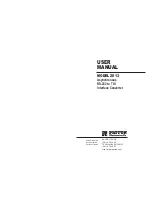
HD Video and Audio Decoder User Manual
DS-6900UDI Decoder User Manual
67
Temperature Measurement and Alarm
Figure 5-36
2.
Set the alarm rule: Select a temperature measurement rule from the rule list and
configure the parameters.
Name:
You can customize the rule name.
Type:
Select point, line, or frame as rule type.
Emissivity:
Set the emissivity of your target. The emissivity of each object is different.
Distance (m):
The straight-line distance between the target and the device.
Reflective Temperature:
If there is any target with high emissivity in the scene, check
the checkbox and set the reflective temperature to correct the temperature. If no such
target exists, uncheck the checkbox.
3.
Click
in the list to show the alarm rule interface.
Alarm Rule:
The alarm rule varies according to different types. The rule is to compare
the temperature information of two selected regions. For targets set by frame, the rules
include:
Max. Temperature is Higher than
,
Max. Temperature is Lower than
,
Min.
Temperature is Higher than
,
Min. Temperature is Lower than
,
Average Temperature is
Higher than
,
Average Temperature is Lower than
,
Temperature Difference is Higher
than
, and
Temperature Difference is Lower than
. For targets set by line, the rules
include
Max. Temperature
,
Min. Temperature
, and
Average Temperature
. For targets
set by point, the rules are distinguished by
Average Temperature
.
Pre-Alarm Temperature and Alarm Temperature:
Set the pre-alarm temperature and
alarm temperature. The device sends pre-alarm when its rule temperature exceeds pre-
alarm temperature and sends alarm when its rule temperature exceeds alarm
temperature.
















































